Featured Exhibits
Sign up for the Newsletter
Advertise on ParachuteHistory.com
Disclaimer
Privacy Policy
About
Mercury
The full scale testing of the Mercury recovery system began on October 9, 1958 at Langley.In March of 1959, 6 main and 12 drogue parachute system were ordered from the Goodyear Aircraft Coppration to support the Little Joe and Big Joe phases of the Mercury Project.
The Mercury recovery system consisted of a drogue parachute and a single main parachute.
During a test drop on April 1, 1959 an extended skirt main was deployed at 10,000 feet. The main parachute squidded and never fully inflated. The test spacecraft did not sustain much damage, but the solid cloth type parachute was determined to be unreliable for deployments over 10,000 feet. A ring sail parachute was adopted.
The final parachute stage in the Mercury project was a ring-sail parachute. The ribbon ring-sail parachute was developed by Theo Knacke. This parachute has good opening characteristics and good stability versus a solid type parachute. The weight of ring-sails are much less than a comparable solid canopy. The top third of the parachute is much like a ring-slot parachute, to allow airflow during the inflation stage. These characteristics made the ring-sail ideal for manned space projects.
Qualification tests on the 63-foot, ringsail main parachute ran from May to August 1959.
In June of 1959 the drogue parachute changed from a 19.5 porosity flat circular ribbon parachute to a 28 percent porosity, 30 degree conical parachute. Complete parachute system landing tests then began with drops from C-130 over the Salton Sea in California.
By September 19 1959, testing was completed on the new drogue design. The drogue acted as a stabilization device and well as a pilot chute for the main parachute. The Mark II Mercury test vehicle was air launched to test the drogue. Fifteen tests were conducted by NASA Flight Research Center.
The drogue parachute was fully qualified for deployment at speeds up to Mach 1.5 and altitudes of up to 70,000 feet. In the operational phase of Project Mercury the drogue parachute was deployed at 40,000 feet. The drogue exceeded normal operational requirements.
Funds for the installation of the reefed ring sail parachute were approved in October 1959.
Sam, an American born Rhesus monkey, tried out the recovery system on December 4, 1959 in a launch of Mercury Little Joe 2 (LJ-2) at Wallops Island. An abort sequence was initiated by timers after 59 seconds of flight at an altitude of 96,000 feet and speed of Mach 5.5.
The escape motors fired and propelled the capsule, with Sam inside, at Mach 6 to an apogee of 53.03 statute miles. The drogue and main parachute deployed properly and returned Sam safely to the ocean. Recorvery of the capsule took about 2 hours.
Sam came through the flight in good shape.
Another test of the abort procedure was tried on May 9, 1960 at Wallops Island. The parachute recovery system worked properly and the test was successful. A Marine helicopter returned the capsule 17 minutes after launch.
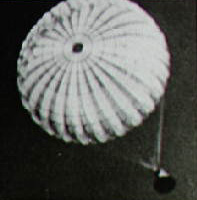 Another abort test flight was conducted April 25, 1961. The Mercury-Atlas 3 launched, flew for 40 seconds and then was destroyed by the range safety officer. The escape motors carried the capsule away and the parachute system deployed successfully. The capsule was recovered off the Cape shore.
Another abort test flight was conducted April 25, 1961. The Mercury-Atlas 3 launched, flew for 40 seconds and then was destroyed by the range safety officer. The escape motors carried the capsule away and the parachute system deployed successfully. The capsule was recovered off the Cape shore.
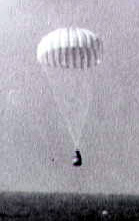 The Mercury capsule descends towards splash down in the Atlantic ocean.
The Mercury capsule descends towards splash down in the Atlantic ocean.

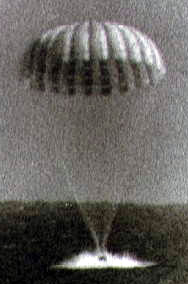 11/25/63
11/25/63
Splashdown of Mercury-Atlas 8 (MA-8) capsule, Sigma 7, with Walter M. Schirra pilot.
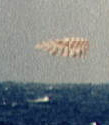 03/26/71
03/26/71
Splashdown of Mercury-Atlas 9 (MA-9) capsule, Faith 7, with L. Gordon Cooper pilot.
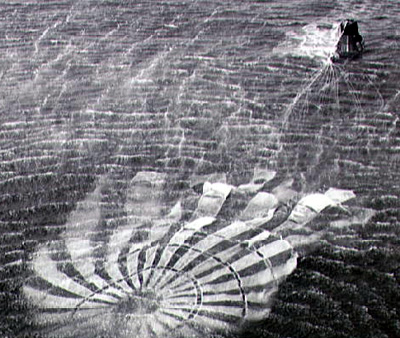
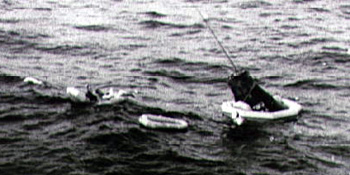
Parachute releases must release the parachutes quickly after the spacecraft lands. The capsule is bouyed upright by floats and a lanyard attached to a helicopter flying above. This recovery is of Scott Carpenter after Mercury-Atlas 7 (MA-7) landed in the Atlantic Ocean. Frogmen helped Carpender into the life raft.
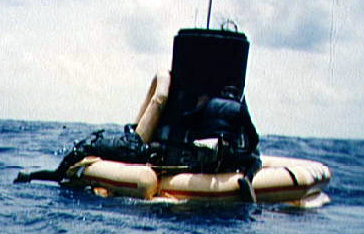
After the parachutes release, frogmen attach a floatation collar around the spacecraft. Mercury-Atlas 9, Faith 7, landed in the central Pacific Ocean near Midway Island. Pilot, L. Gordon Cooper Jr., did not get out of the capsule while in the water. The entire capusule with pilot on board was lifted onto the USS Kearnage.
NASA Photos
[Products] | [Services]
[Join Our Mailing List] | [Advertise on ParachuteHistory.com]
[ ]
[Disclaimer] | [Privacy Policy] | [About]